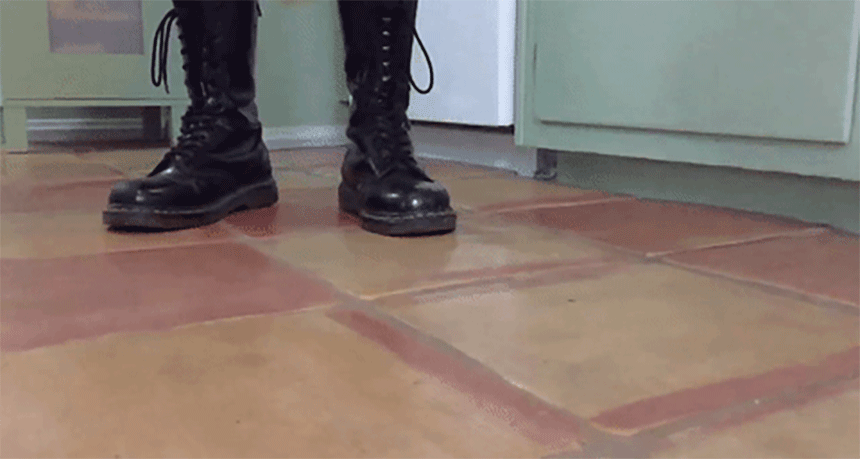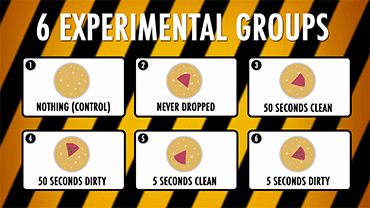The five-second rule: Designing an experiment
You can do research at home to test a common belief about food safety

Oops! Is that muffin still safe to eat? The latest DIY Science video tests if the five-second rule is true.
Explainr
Share this:
- Share via email (Opens in new window) Email
- Click to share on Facebook (Opens in new window) Facebook
- Click to share on X (Opens in new window) X
- Click to share on Pinterest (Opens in new window) Pinterest
- Click to share on Reddit (Opens in new window) Reddit
- Share to Google Classroom (Opens in new window) Google Classroom
- Click to print (Opens in new window) Print
This article is one of a series of Experiments meant to teach students about how science is done, from generating a hypothesis to designing an experiment to analyzing the results with statistics. You can repeat the steps here and compare your results — or use this as inspiration to design your own experiment.
Everyone has dropped food on the floor by accident. And if the floor is fairly clean and you’re hungry, you might pick up that food and eat it. You may even say “five-second rule!” as you bend down to grab it. The idea is that the food hasn’t been sitting on the floor long enough for bacteria to hop on board. But does time matter to a microbe?
Our latest DIY Science video examines the bugs on your bologna with an experiment. We’re not the first to tackle falling foods with science. The five-second rule has been tested in several scientific papers. And Mythbusters probed the issue on TV. But you don’t need a lot of money or a laboratory to test this yourself. In this series of blog posts, you’ll discover everything you need — from building an incubator to analyzing the data.
The five-second rule implies that if food is picked up quickly after it’s dropped, germs won’t have time to get on board. To find out if that’s true, we start with a hypothesis — a statement that can be tested. Because the five-second rule involves a specific length of time, we’ll need to compare food left on the floor for different periods of time.
Hypothesis: Food picked up off the floor after five seconds will collect fewer bacteria than food left on the floor for 50 seconds.
To test this hypothesis, we need to pick a food to test. That food should be something that can be easily dropped and easily picked up. And being inexpensive will help, since we’ll be dropping a lot of it. So we picked — bologna!
Our hypothesis compares two time periods, five seconds and 50 seconds. But that doesn’t mean we can test only one piece of bologna for five seconds against one left on the floor for 10 times as long. We also have to find out whether the bologna had microbes on it before it was dropped. Not only that, we have no idea how clean the floor is!
This means we actually need to test six groups, not two. The first is a control, meaning no bologna. This group will test our germ-growing set-up (more on that later) and will let us see how many bacteria grow without the lunch meat or contact with the floor. The second group will grow microbes from bologna straight out of the package (slices that will never have touched the floor).

How clean the floor is might also matter. In the end, I need to drop bologna on two sections of my tiled floor, each for two time periods. One section of floor should be as clean as possible. The other should be good and dirty — but look clean. We’ll drop pieces of bologna on each tiled section of floor, waiting five or 50 seconds before picking any up.
So those are the six groups, or test conditions. But testing each condition only once won’t be enough. This is because the number of microbes on each of the cold cuts will probably vary a lot. To make sure that the experiment represents what might happen to bologna in general, we need to replicate each several times. To find out how many times, I spoke with Iain Sawyer. He’s a cell biologist at Rosalind Franklin University of Medicine and Science in North Chicago, Ill.
There are two kinds of replication that we need to worry about, Sawyer notes: technical replicates and biological replicates.
A technical replication accounts for differences in how an experiment is conducted. For example, each bologna slice will probably produce slightly different results. A slice might be left out slightly longer before being dropped, allowing germs to grow. Or I might not clean my hands perfectly each time, introducing bugs. A biological replication is one that will account for differences in the living world. There are many species of bacteria, for instance, and they may concentrate more in one spot of floor than in another.
The best plan is to repeat the experiment more than once per group over several days, Sawyer says. This ensures we perform the test many times, which addresses the issues in the technical replication. It means we will perform the experiment in different temperatures and at different times. And dropping more than one piece of bologna for each group each day controls for how much the microbes might vary from one spot of floor to another. This should address any biological variation. In total, we will drop six pieces of bologna per group for each of the six groups, spread out over three days. That’s a total of 36 slices of lunch meat.
Just dropping bologna won’t help us discover if our hypothesis was right, though. We need to measure whether the numbers of bacteria change as a result of how long the food spent on the floor. But bacteria are too small to see without a microscope. And even with a microscope, it would be impossible to count all those germs. So we’ll have to grow the microbes — or culture them — into groups large enough to see. Read the next post to learn how to grow your own germs!
Is the five-second rule really true? We’re designing an experiment to find out.







